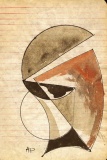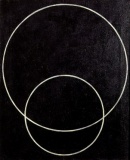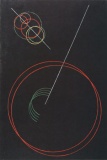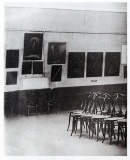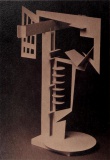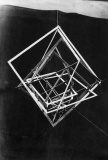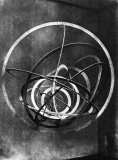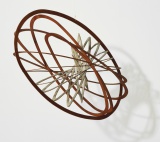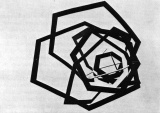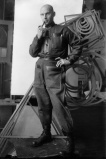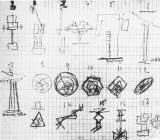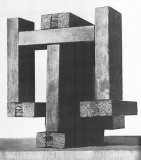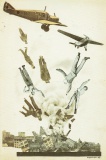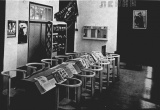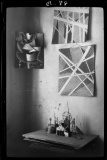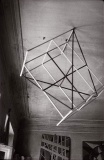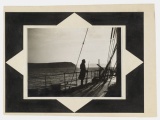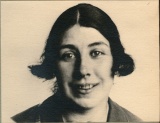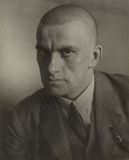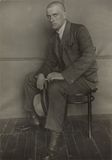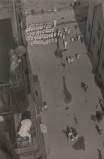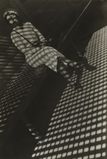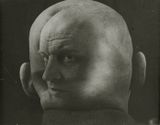Alexander Rodchenko
 with Varvara Stepanova, 1920s. | |
| Born |
December 5, 1891 St Petersburg, Russian Empire |
|---|---|
| Died |
December 3, 1956 (aged 64) Moscow, Soviet Union |
| Collections | Costakis, Costakis, MoMA, Tretyakov, Van Abbemuseum, RGALI |
Aleksander Mikhailovich Rodchenko (Александр Михайлович Родченко; 1891–1956) was a Russian artist, sculptor, photographer and graphic designer. He was one of the founders of constructivism and Russian design. He was married to the artist Varvara Stepanova.
Contents
Chronology[edit]
This chronology is sourced from the website of MoMA, 1998. Dates before 1 Feb 1918 follow the Old Style/Julian calendar (lagging 13 days behind the New Style/Gregorian calendar). Entries for most years start with a list of exhibitions in Russia (and several significant ones abroad) in which Rodchenko's work was included; not included are the five or six photographic salons outside Russia in which, on average, Rodchenko exhibited each year from 1926 through the early 1940s.
- 1891
- November 23 (December 5 New Style): Aleksandr Mikhailovich Rodchenko born in Saint Petersburg. Father, Mikhail Mikhailovich Rodchenko (born 1852), is a prop man in the theater; mother, Ol'ga Evdokimovna Paltusova (born 1865), is a washerwoman.
- 1905
- By this year, family has moved to Kazan.
- August 20: Receives a certificate of elementary education from the Kazan school board.
- 1907
- Father dies.
- 1908
- Begins two years of apprenticeship as a dental technician.
- 1910
- September: Enrolls in the department of figurative arts in the Kazan School of Fine Arts (Kazanskaia khudozhestvennaia shkola).
- Gives drawing lessons.
- 1912
- Writes poems and tries to have them published, without much success.
- 1913
- 2nd Periodic Exhibition of Painting (2aia periodicheskaia vystavka kartin), Kazan. Organized by the Kazan School of Fine Arts.
- 3rd Periodic Exhibition of Painting (3aia periodicheskaia vystavka kartin), Kazan. Organized by the Kazan School of Fine Arts.
- 1914
- 5th Painting Exhibition (5aia vystavka kartin), Perm. Organized by the Perm Society of Friends of Painting, Sculpture, and Architecture (Permskii obshchestvo liubitelei zhivopisi, vaianiia i zodchestva).
- Meets [[Stepanova|Varvara Fedorovna Stepanova]] (born 1894), also a student at the Kazan School of Fine Arts.
- February 20: Attends lecture and performance presented in Kazan by Russian Futurists David Burliuk, Vasilii Kamenskii, and Mayakovsky. Becomes an adherent of Futurism (which in Russia designates a wide range of avant-garde experiment). Purchases a photograph of Mayakovsky.
- June 7: Although his lack of formal secondary education prevents him from receiving a diploma, obtains a certificate stating that he has completed the course of painting and drawing at the Kazan School of Fine Arts.
- 1915
- October: This month or shortly thereafter moves to Moscow and enrolls in the Graphic Section of the Stroganov School of Applied Art (Stroganovskoe khudozhestvenno-promyshlennoe uchilishche).
- 1916
- The Store (Magazin), Moscow. March.
- Modern Painting (Sovremennaia zhivopis'), Moscow.
- March: Opening of The Store (Magazin), Moscow. Organized by Tatlin in a rented shop at 17 Petrovka Street, the exhibition includes Rodchenko's compass-and-ruler drawings. Other exhibitors are Ivan Bruni, Exter, Kliun, Malevich, Vera Prestel', Popova, Udaltsova, Maria Vasil'eva, and Tatlin himself.
- Spring-Summer: Departs for military service as operations manager of a hospital train.
- 1917
- Exhibition of Works by Rodchenko 1910-1917 (Vystavka tvorchestva Rodchenko 1910-1917), Moscow. March or May.
- Summer: Rodchenko is a founder of Profsoiuz (Professional'nyi soiuz khudozhnikov-zhivopistsev, Professional Union of Artist-Painters) and becomes the secretary of its "left" or avant-garde division, the Young Federation (Molodaia federatsiia). Although relatively small, this "left" federation is assertive enough to get four of its members (Mayakovsky, Altman, Punin, and Meyerhold) on the union's organizing committee.
- Fall: With Tatlin and others, assists Georgii Yakulov in designing the Café Pittoresque on Kuznetskii Most in Moscow. Rodchenko designs lamps and makes large-scale working drawings from Yakulov's rough sketches. The café will open on January 30, 1918.
- December: Rodchenko is discharged from military service.
- 1918
- 1st Exhibition of Painting (1aia vystavka kartin), Moscow. Organized by Profsoiuz.
- 5th State Exhibition: "From Impressionism to Non-Objective Art" (5aia gosudarstvennaia vystavka: "Ot Impressionizma do bespredmetnogo iskusstva"), Moscow. Organized under the auspices of IZO Narkompros.
- 5 Years of Work (5 let raboty), club of the Young Federation for New Art (Molodaia federatsiia novogo iskusstva), Moscow.
- Untitled group exhibition, club of the Young Federation for New Art, Moscow.
- Becomes a member of the presidium of the soviet of Profsoiuz.
- January 29: Establishment of IZO (Otdel izobrazitel'nykh iskusstv, the Section of Visual Arts), a department of Narkompros. Painter David Shterenberg is appointed head of the Petrograd section, which includes Mayakovsky, Brik, and Altman. Tatlin is head of the Moscow section, which includes Malevich, Kandinsky, Rodchenko, and others.
- Rodchenko will assist Rozanova, head of the Art and Production Subsection (Khudozhestvenno-promyshlennyi podotdel) of IZO, in visiting workshops and studios and raising money to revive craft production. He will be named head of the Museum Bureau (Muzeinoe biuro) of IZO, and of its Moscow centerpiece, the Museum of Painterly Culture (Muzei zhivopisnoi kul'tury), and will be assisted in these positions by Stepanova. Over the next three years, the Museum Bureau will acquire 1,926 works of modern and contemporary art by 415 artists and will organize thirty provincial museums, to which it will distribute 1,211 works.
- February: A Moscow branch of Proletkul't is established. Rodchenko will teach a course on the theory of painting here.
- Spring: Rodchenko publishes in the anarchist magazine Anarkhiia.
- Second half of the year: Works for the first time in abstract sculpture, producing a series of spatial constructions that he calls "white sculptures."
- 1919
- 10th State Exhibition: Non-Objective Creation and Suprematism (10aia gosudarstvennaia vystavka: Bespredmetnoe tvorchestvo i Suprematizm), Moscow. Organized by IZO Narkompros. April.
- 11th State Exhibition (11aia gosudarstvennaia vystavka), Moscow. Organized by IZO Narkompros.
- 3rd Exhibition of Painting (III vystavka kartin), Ryazan. Organized by the public-education department of the Ryazan regional government.
- 1st State Painting Exhibition of Local and Moscow Artists (1aia gosudarstvennaia vystavka kartin mestnykh i moskovskikh khudozhnikov), Vitebsk. Organized by the fine-arts section of the education department of the Vitebsk regional government.
- Produces a series of linocuts; executes his first collages using printed materials; starts work on a series of architectural drawings, and also on a series of spatial constructions that can be stored flat and then opened up into three-dimensional hanging forms.
- Joins the Collective of Painterly, Sculptural, and Architectural Synthesis (Zhivskul'ptarkh, the Kollektiv zhivopisno-skul'pturno-arkhitekturnogo sinteza). Wins first prize in a competition, organized by the collective, to design a newspaper kiosk.
- Aleksandr Drevin, Popova, Rodchenko, Stepanova, Aleksandr Vesnin, and Udaltsova form Asskranov (Assotsiatsiia krainikh novatorov, Association of Radical Innovators), in opposition to Malevich's Suprematism.
- April 27: Opening of the 10th State Exhibition: Non-Objective Creation and Suprematism (10aia gosudarstvennaia vystavka: Bespredmetnoe tvorchestvo i Suprematizm). Rodchenko shows his "Black on Black" (Chernoe na chernom)series, in response to Kazimir Malevich's "White on White" (Beloe na belom) canvases.
- September 15: With Stepanova, moves into Kandinsky's apartment at 8 Dolgii Lane (now Burdenko Street).
- December: Proletkul't becomes an autonomous body within Narkompros.
- 1920
- Exhibition of the Four Painters Kandinsky, Rodchenko, Sinezubov, Stepanova (Vystavka chetyrekh khudozhnikov Kandinskii, Rodchenko, Sinezubov, Stepanova), Moscow.
- State Exhibition "Zhivskul'ptarkh" (Gosudarstvennaia vystavka "Zhivskul'ptarkh"), Moscow.
- Exhibition to the Third Congress of the Komintern (Vystavka k III kongressu kominterna), Moscow.
- 1st State Exhibition of Art and Science (1aia gosudarstvennaia vystavka iskusstva i nauki), Kazan.
- 2nd Art Exhibition (2aia khudozhestvennaia vystavka), Sovetsk. Organized by the Subsection of the Department of Museums and Conservation of Monuments and Antiquities (Podotdel po delam museev i okhrany pamiatnikov iskusstva i stariny).
- 1st Kosmodem'iansk Exhibition for the Third Anniversary of the Great October Revolution (1aia kozmodem'ianskaia vystavka k 3ei godovshchine velikoi oktiabr'skoi revolutsii), Kosmodem'iansk. Organized by IZO.
- 19th State Exhibition (19aia gosudarstvennaia vystavka), Moscow. Organized under the auspices of IZO Narkompros. October.
- Organizes, designs, and participates in Exhibition to the Third Congress of the Komintern (Vystavka k III kongressu kominterna).
- May: Formal establishment of Inkhuk (Institut khudozhestvennoi kul'tury, the Institute of Artistic Culture) under the auspices of IZO Narkompros. It has grown out of meetings among Kandinsky, Rodchenko, Stepanova, Vladimir Franketti, Viktor Shestakov, and others. Its initial program is formulated by Kandinsky.
- For the 19th State Exhibition (19aia gosudarstvennaia vystavka), organized under the auspices of IZO Narkompros, Rodchenko prepares two essays, "Everything is Experiment" (Vse-opyty), which is displayed in the exhibition next to his work, and "The Line" (Liniia), which announces a new cycle of work. The exhibition opens on October 20, and here Rodchenko meets Mayakovsky.
- October 24: With Stepanova, moves out of Kandinsky's apartment.
- November: Becomes a professor at Vkhutemas, where he will teach "Construction," a mandatory course, and give the lectures "Initiative" and "Graphic Construction of a Plane" for one year.
- November 5: With Stepanova, moves into an apartment in the building of the Museum Bureau, at 14 Volkhonka Street.
- November 14: Gan invites him to design for Gan's play We (My).
- November 23: Formation of the General Working Group of Objective Analysis (Obshchaia rabochaia gruppa ob'ektivnogo analiza) within Inkhuk. Including Aleksei Babichev, Rodchenko, Stepanova, and others, it coheres in opposition to Kandinsky's program and leadership. Babichev would later write, "The psychological approach of Kandinsky sharply diverged from the views of those who considered the material, self-contained 'object' to be the substance of creation."
- 1921
- 3rd Touring Fine Art Exhibition of the Regional Subsection of the Central Museum of Sovetsk (3aia peredvizhnaia khudozhestvennaia vystavka sovetskogo raionnogo podotdela glavmuzeia), Sovetsk.
- Second Spring Obmokhu Exhibition (Vtoraia vesenniaia vystavka Obmokhu), held in the former Mikhailova Salon, Moscow. May-June.
- 5x5=25 exhibition held at the Club of the All-Russian Union of Poets (Klub vserossiskogo soiuza poetov), Moscow. Part one September, part two October.
- Wins first prize in a competition to design union insignia.
- February: Teaches drawing for one term at the Ceramics Faculty (Keramicheskii fakul'tet) of Vkhutemas.
- March 18: Forms the First Working Group of Constructivists (Pervaia rabochaia gruppa konstruktivistov) with Gan, Karl Ioganson, Konstantin Medunetskii, Stepanova, and Georgii and Vladimir Stenberg.
- May 22: Opening of the second Obmokhu exhibition--called the Second Spring Obmokhu Exhibition (Vtoraia vesenniaia vystavka Obmokhu)--in Moscow. Ioganson, Medunetsky, the Stenberg brothers, and others exhibit, and Rodchenko shows spatial constructions.
- September-October: With Exter, Popova, Stepanova, and Alexander Vesnin, presents work in 5x5=25, a two-part exhibition held at the Club of the All-Russian Union of Poets (Klub vserossiskogo soiuza poetov). Each artist shows five works in each part. The first part opens in September and features works especially produced for the occasion; Rodchenko exhibits Line (Liniia, 1920), Grid (Kletka, 1921), and the three monochrome paintings Pure Red Color (Chistyi krasnyi tsvet), Pure Yellow Color (Chistyi zheltyi tsvet), and Pure Blue Color (Chistyi sinii tsvet, all 1921), which are often referred to as a triptych. The second part of the show, in October, is dedicated to works on paper.
- November 26: Rodchenko reads his essay "The Line" (Liniia) at an Inkhuk meeting.
- Rodchenko works on free-standing sculptures made of identically sized wooden elements.
- 1922
- First Russian Art Exhibition (Erste russische Kunstausstellung), Galerie van Diemen, Berlin. October-December.
- February: Becomes the dean of the metalworking faculty (Metalloobrabatyvaiushchii fakul'tet, or Metfak) at Vkhutemas. Is replaced as the head of IZO's Museum Bureau.
- February 22: Rodchenko and Stepanova are allocated an apartment at 21 Miasnitskaia Street, where they will live for the rest of their lives. The building is across the courtyard from Vkhutemas.
- August: First issue of the magazine Kino-Fot (Cine-Photo). Editor Gan invites Rodchenko to design its covers. Through Gan, Rodchenko meets Vertov.
- October 15: Opening of the First Russian Art Exhibition (Erste russische Kunstausstellung), at the Galerie van Diemen, 21 Unter den Linden, Berlin. The exhibition, which includes work by Rodchenko, is Western Europe's first comprehensive overview of Russian modernist art. It will later travel to the Stedelijk Museum, Amsterdam.
- November: At Vertov's invitation, Rodchenko designs intertitles for Kino-Pravda numbers 13 and 14.
- 1923
- Exhibition of Moscow Stage Design 1918-1923 (Vystavka teatral'no-dekorativnogo iskusstva Moskvy 1918-1923), Moscow.
- Acquires a 13-by-18-cm. view camera to make copies, enlargements, and reductions for his photocollage work.
- Begins to design advertisements and insignia for the state airline Dobrolet. This work soon leads to regular collaborations with Mayakovsky (who writes the slogans) on advertisements for the state grocery-concern Mossel'prom, the state candy-maker Krasnyi Oktiabr', the state department-store gum, the state rubber-trust Rezinotrest, the state tea-producer Chaiupravlenie, and the state publishing-house Gosizdat.
- Receives graphic design commissions, mainly for book covers and posters, from Gosizdat, Komakademiia (Communist academy), Krug (Circle), Molodaia gvardiia (Young Guard), and Transpechat' (Transport Press), and from the magazines Krasnaia Nov' (Red Soil) and Molodaia Gvardiia.
- Shows costume designs for Gan's play We in the Exhibition of Moscow Stage Design 1918-1923 (Vystavka teatral'no-dekorativnogo iskusstva Moskvy 1918-1923).
- His Metfak students at Vkhutemas exhibit furniture designs based on his principles of efficiency and multiple applications, including a bed that can double as an armchair, by N. Sobolev; a collapsible bookstand, by Zakhar Bykov; and a folding bed, by Peter Galaktionov.
- March: Manifesto of the Lef group (signed by Aseev, Arvatov, Brik, Kushner, Mayakovsky, Tretyakov, and Chuzhak) appears in the first issue of the group's magazine Lef, published with support from Narkompros. The press run of this first issue is 5,000; over the course of Lef 's seven issues (through January 1925) it will decline to 2,000. The first issue includes Rodchenko's drawings for "cinema cars," a mobile system of film projection that he has designed for the All-Russian Agricultural Exhibition (Vserossiiskaia vystavka sel'sko-khoziaistva), Moscow, but that are never produced.
- Rodchenko will design all the covers of Lef, and will become the Lef group's principal visual artist. Filmmakers Eisenstein and Vertov, stage director Meyerhold, and literary theorist Shklovsky will also become associated with the group.
- April 21: Completes photocollage maquettes as the cover and illustrations for About This (Pro eto), a poem by Mayakovsky, which the poet has completed on February 11.
- June 5: Publication of Pro eto.
- July 1: The newspaper Izvestiia publishes a full-page advertisement for the department store gum (Gosudarstvennyi universalnyi magazin, the State universal store) designed by Rodchenko with text by Mayakovsky, their first advertising collaboration.
- December 18: Moholy-Nagy, professor at the Bauhaus, writes to Rodchenko at Vkhutemas, inviting him to write a brochure on Constructivism for a series to be published by the Bauhaus. The brochure will never appear.
- Winter of 1923-24: Makes a small number of photographs independent of his collage work.
- 1924
- Rodchenko stops working for Inkhuk.
- April: In his apartment on Miasnitskaia Street, using a 9-by-12-cm. plate camera, makes a series of six portraits of Mayakovsky, his first lasting work in photography. Soon begins to photograph family and friends.
- October 31: Release of Vertov's film Cine-Eye (Kino glaz), for which Rodchenko designs the poster.
- 1925
- 3rd Art Exhibition of Painting by Kaluga and Moscow Artists (3aia khudozhestvennaia vystavka kartin kaluzhskikh i moskovskikh khudozhnikov), Kaluga.
- First Exhibition of Film Posters (Pervaia vystavka kino-plakat), Moscow.
- Exposition Internationale des Arts Décoratifs et Industriels Modernes, Paris.
- Rodchenko publishes photo-reportage in the magazines Ogonek [The Little Flame], Tridtsat' Dnei [Thirty Days], and Ekran Rabochei Gazety [Screen of the Worker's Newspaper].
- A mural that Rodchenko has designed for the side of the Mossel'prom building in Moscow is completed by this month, when he photographs it in its finished state.
- January 14: A daughter, Varvara Alexandrovna Rodchenko, is born to Stepanova and Rodchenko.
- January 18: Release of Eisenstein's film Bronenosets Potemkin [The Battleship Potemkin], for which Rodchenko designs the poster.
- March 23: Arrives in Paris by train, via Riga (March 19) and Berlin (March 20), as part of the delegation, headed by David Shterenberg, that will mount the Soviet exhibitions at the Exposition Internationale des Arts Décoratifs et Industriels Modernes. These exhibitions include six rooms in the Grand Palais, containing a model village reading room and a theater, as well as exhibits of crafts, works created at Vkhutemas, graphic design, advertising, and architecture; and also the Soviet Pavilion, designed by Melnikov, and, at the Invalides, a model workers' club (Rabochii klub), designed by Rodchenko, who also executes its installation and that of the other exhibitions.
- In Paris, visits the Salon des Indépendants, which he finds mediocre, and meets Theo van Doesburg, Fernand Léger, and other artists, in meetings limited by the lack of a common language. Writes almost daily to Stepanova of his impressions of Paris: considers the advertising weak; admires Charlie Chaplin's The Kid. Also buys a 4-by-6.5-cm. Ica plate camera and a 35-mm. Sept (a movie camera that can also make still frames). Buys a second Sept for Vertov.
- June 4: Soviet exhibitions open in the Grand Palais. Rodchenko wins silver medals in each of the four categories he has entered: book design, outdoor advertising, theater design, and furniture design.
- June 18: Leaves Paris for Moscow, by train.
- Fall: Shooting from both above and below, makes "The Building on Miasnitskaia Street" (Dom na Miasnitskoi), a series of photographs of his apartment building.
- 1926
- 2nd Exhibition of Film Posters (2aia vystavka kino-plakat), Moscow. Organized by the publishing house Teakinopechat' (Press for theater and cinema).
- The magazine Sovremennaya arkhitektura (Contemporary Architecture)goes into publication, edited by Gan. Rodchenko and Stepanova contribute to the first issues.
- Begins to photograph regularly and to design costumes and sets for theater and film.
- Commissioned by the Museum of the Revolution (Muzei revolutsii) and Komakademiia to create "The History of the VKP(b) (All-Russian Communist Party [Bolshevik]) in Posters" (Istoria VKP(b) v plakatakh), a series of twenty-five posters illustrating the history of the Communist Party.
- February: Joins the Association of Photo-Reporters (Assotsiatsiia fotoreporterov) but does not participate in its first exhibition, at the Press-House (Dom pechati).
- March: The magazine Sovetskoe Kino (Soviet Cinema) includes photographs from Rodchenko's "Building on Miasnitskaia Street" series of 1925. He will contribute photographs to the magazine regularly.
- April: First issue of Sovetskoe Foto (Soviet Photography), a monthly addressed primarily to amateur photographers, published under the auspices of IZO Narkompros. Rodchenko is a member of the editorial board.
- 1927
- All-Union Exhibition of Graphic Design (Vsesoiuznaia poligraficheskaia vystavka), Leningrad.
- 10 Years of Russian Xylography (Russkaia ksilografiia za 10 let), State Russian Museum (Gosudarstvennyi russkii muzei), Leningrad.
- Exhibition organized by OSDK, Moscow.
- Rodchenko collaborates on Moscow in October (Moskva v Oktiabre) by Boris Barnet, one of three films commissioned to celebrate the tenth anniversary of the October Revolution. Listed as "Artist" (Khudozhnik) in the film's credits, he selects locations and designates camera viewpoints and angles, many of them from above or below. In connection with the film, he photographs extensively in Moscow and makes a series of photographs of the Brianskii railway station, site of the film's opening scene. The film is released in November of this year.
- Designs the sets, notably the hero's apartment, conceived as an exemplar of modern functional design, for the film The Journalist (Zhurnalistka), by Lev Kuleshov (released in October of this year). Also designs sets for the film Al'bidum, by Leonid Obolenskii.
- Rodchenko's poster series "The History of the VKP(b) in Posters," of 1926, is published in the newspapers Izvestiia and Pravda.
- January: First issue of the magazine Novyi Lef. Twenty-two monthly numbers (including one double number) will appear through December 1928, in editions ranging from 2,400 to 3,500. Rodchenko will design all of the covers and will contribute regularly to the contents.
- Designs advertising poster for Novyi Lef, composed of portraits of Aseev, Brik, Eisenstein, Semen Kirsanov, Kushner, Anton Lavinskii, Mayakovsky, P. Nezmanov, Pasternak, Viktor Perstov, Rodchenko, Shklovsky, Stepanova, Tretyakov, Vertov, and Vitalii Zhemchuzhnyi.
- February: Novyi Lef number 2 publishes excerpts from Rodchenko's letters to Stepanova from Paris in 1925.
- Summer: Exhibits photographs for the first time, in a Moscow exhibition organized by Odsk (Obshchestvo druzei sovetskogo kino, the Society of the Friends of Soviet Cinema).
- 1928
- 10 Years of Soviet Photography (Sovetskaia fotografiia za 10 let), Moscow and Leningrad. Organized by the State Academy of Artistic Sciences.
- Russian Drawing in the 10 Years after the October Revolution (Russkii risunok za 10 let Oktiabr'skoi revoliutsii), State Tretyakov Gallery (Gosudarstvennaia Tretiakovskaia galereia), Moscow.
- In the exhibition 10 Years of Soviet Photography (Sovetskaia fotografiia za 10 let), in Moscow, Rodchenko's pictures are shown in the photo-reportage section, not the "artistic photography" section. Following the exhibition, Voks establishes a photographic section. Rodchenko sits on the section's committee. Through the wide-ranging contacts of VOKS, he will send photographs to an average of five or six foreign exhibitions, many of them Pictorialist salons, each year through 1941.
- Designs sets for the film The Doll with Millions (Kukla s millionami), by Sergei Komarov (released in December of this year).
- Over the next four years, will publish photo-reportage in the magazines Kniga i Revoliutsiia (Book and Revolution),Kommunisticheskii Internatsional Molodezhi (Communist International of Youth),Krasnoe Studenchestvo (Red Student Days), Pioner (Pioneer), Prozhektor (Projector), Sovetskoe Foto, Radioslushatel' (Radio Listener), Smena (Change), and Zhurnalist (Journalist).
- January 3: Alfred H. Barr, Jr., future founding director of The Museum of Modern Art, New York, visits Rodchenko and Stepanova at their apartment in Moscow.
- April: Sovetskoe Foto no. 4 of 1928 publishes an anonymous illustrated letter to the editor insinuating that Rodchenko has plagiarized his photographic style from Western "imperialist" photographers.
- October 3: L. Averbakh of Rapp attacks Rodchenko's photograph of a pioneer as "monstrous."
- November: Maks Tereshkovich, director of the Theater of the Revolution (Teatr revoliutsii), invites Rodchenko to design sets for the play Inga, by Anatolii Glebov. Explaining his participation in the production in his essay "A Discussion of the New Clothing and Furniture--A Task of Design," Rodchenko will emphasize the notion of rationality, the use of fold-out (rather than multiple-application) furniture (the better to suit everyday living conditions), and his preference for an "abundantly available" material, wood.
- November 14: Delivers an illustrated lecture, "On the New Photography or Photo-Lef," at GaKhn (Gosudarstvennaia akademiia khudozhestvennykh nauk, the State Academy of Artistic Sciences).
- November 25: Stepanova's diary records Rodchenko's purchase of a Leica for 350 rubles.
- December 9: Lissitzky, charged with assembling the Russian section of the forthcoming Film und Foto exhibition in Stuttgart, visits Rodchenko to select photographs for the exhibition.
- December 26: With Stepanova, Rodchenko completes the maquette for a book of photographs of his that have appeared in Sovetskoe Foto, Sovetskoe Kino, and Novyi Lef. Brik is to write an introduction. The book is to be published under the auspices of Narkompros, but never appears.
- 1929
- 1st Exhibition of the Association of the Moscow Stage Designers (1aia vystavka Moskovskoi assotsiatsii khudozhnikov-dekoratov), Moscow.
- Soviet Drawing (Sovetskii risunok), Kuibyshev.
- Internationale Ausstellung des Deutschen Werkbunds Film und Foto, Stuttgart. May 18-July 17.
- Rodchenko joins the interior design section of October.
- January 2: Mayakovsky invites Rodchenko to work on his play Bedbug (Klop), at the Meyerhold Theater (Teatr im. Vs. Meierkhol'da). Rodchenko will work on the project from January 14 to February 13. His designs are for the second half of the play, which is set in 1979, fifty years in the future. Designs for the first half of the play, set in the present day of 1929, are by the Kukrinskii brothers. Once Rodchenko has finished his work for Bedbug, he returns to designing modular furniture for Glebov's play Inga, to open later in the spring.
- April: First issue of the magazine Daesh' (Give Your All), closely associated with October. Daesh' will survive for fourteen issues, the last of them published in December of this year. Principal photographers for the magazine are Rodchenko and Boris Ignatovich.
- Summer: After the Film und Foto exhibition in Stuttgart, enters into correspondence with co-organizer Jan Tschichold.
- 1930
- First October exhibition, Gorky Park, Moscow. Opens March 27.
- 20 Years of the Work of Mayakovsky (20 let raboty Maiakovskogo), Writers' Club (Klub pisatelei), Moscow.
- Exhibition of Drawings (Vystavka risunkov), Perm.
- Revolutionary and Socialist Themes (Revoliutsionnaia i sotsialisticheskaia tematika), State Tretyakov Gallery, Moscow.
- Rodchenko lectures on photography to heads of photographic clubs at the Institute of Graphic Design (Poligraficheskii institut) and the Association of Photo-Reporters.
- February: A photographic section of the October group is organized. Rodchenko is head of the section and writes its program. Other members include Dmitrii Debabov; Boris, Ol'ga, and Elizaveta Ignatovich; Vladimir Griuntal'; Roman Kamen; Eleazar Langman; Moriakin; Abram Shterenberg; and Vitalii Zhemchuzhnyi.
- March 27: First general October exhibition opens at Gorky Park (Park kul'tury i otdykha im. Gorkogo, or Park of culture and rest named after Gorky), Moscow. The photography section, organized by Rodchenko and Stepanova, includes the magazine Radioslushatel', designed by Stepanova and illustrated with photographs by Griuntal', Boris Ignatovich, and Rodchenko.
- July: First issue of the magazine Za Rubezhom (Abroad). Rodchenko will design many of its covers.
- August-November: With the film director Leon Letkar, travels to Vakhtan to shoot the documentary Chemical Treatment of the Forest (Khimizatsiia lesa). The film will never be released. During the trip makes a series of photographs at a lumber mill.
- 1931
- Exhibition of the photographers' section of October at the Press-House, Moscow. May.
- October exhibition of photomontage in Gorky Park, Moscow. June.
Designs the costumes and sets for the revue Sixth Part of the World (Shestaia chast' mira), by Aleksandr Zharov, and directed by Nikolai Gorchakov, at the Music-Hall Theater.
- Set designer for the film What Will You Be? (Kem byt'?), directed by Vitalii Zhemchuzhnyi and based on a children's book by Mayakovsky.
- Begins lecturing on photography at the Soiuzfoto agency.
- May: The October photographers' section opens an exhibition at the Press-House. Rodchenko shows his photographs from Vakhtan.
- October 10: Tschichold writes asking Rodchenko to send about sixty photographs for a prospective monograph in a series of books he is preparing with Franz Roh. The book will never appear.
- 1932
- Exhibition dedicated to the work of Mayakovsky, Moscow. Organized by the Museum of Literature (Muzei literatury).
- Rodchenko designs the sets and costumes for the play The Army of the World (Armiia mira), by Lev Nikulin, directed by Iurii Zavadskii at the Zavadskii Theater.
- Teaches a course on photography at the Institute of Graphic Design.
- Makes photo-vitrines for the Dynamo (Dinamo) stadium.
- January: This month's Proletarskoe Foto includes attacks on the October group. On January 25, Rodchenko is expelled from October for resistance to the "practical reconstruction of the group."
- February: Proletarskoe Foto publishes workers' criticisms of photographs by members of October, notably Rodchenko's pictures of pioneers. It also publishes an open letter signed by eighteen members of October, including Rodchenko (not yet expelled when the letter was written), apologizing for the group's mistakes.
- April 15: Signs a one-year contract to supply photographs to Izogiz (the State Publishing House for Art). The contract calls for Rodchenko to supply a minimum of forty photographs per month at ten rubles each, for a monthly salary of 400 rubles. Additional photographs will earn from ten to twelve rubles each, depending on quality. The contract leads to, among other things, the publication of a series of approximately forty postcards of Moscow scenes, published in editions ranging from 10,000 to 25,000, and to the preparation of Dve Moskvy (Two Moscows), a book documenting Moscow before the Revolution (through drawings) and after it (through Rodchenko's photographs). The book will never appear. Rodchenko's work is, however, included in the photo-album From Capitalist Moscow to Socialist Moscow (Ot Moskvy kupecheskoi k Moskve sotsialisticheskoi).
- 1933
- 15 Years of Artists of the RSFSR (Russian Soviet Federal Socialist Republic) (Khudozhniki RSFSR [Rossiiskaia Sovetskaia Federativnaia Sotsialisticheskaia Respublika] za 15 let), Moscow.
- A law requiring a permit to photograph openly in Moscow henceforth restricts Rodchenko's photographic work to official parades and sporting events, the circus, the theater, commissions outside Moscow, and private pictures.
- Rodchenko joins Mosskh.
- February: Commissioned by Izogiz to travel to Karelia to photograph the construction of the White Sea (Belomorsk) Canal, which connects the White Sea and the Baltic. Spends two weeks at the canal.
- March 13: Departs on a second trip to the White Sea Canal.
- Summer: Third and final trip to the canal to photograph its inauguration. On the three trips together, has made a total of some 4,000 negatives.
- July 18: Rodchenko's mother dies in Moscow while he is photographing at the White Sea Canal.
- December: SSSR na Stroike publishes a special issue on the White Sea Canal, designed by Rodchenko and largely illustrated with his photographs.
- Over the next eight years Rodchenko and Stepanova will work regularly on SSSR na Stroike.
- 1934
- Travels to the Crimea and the Donets Basin on photographic assignments from Izogiz.
- With Stepanova, designs 10 Years of Soviet Uzbekistan (10 let sovetskogo Uzbekistana), an album of photographs.
- 1935
- 17 Years of Artists of the Soviet Theater (Khudozhniki sovetskogo teatra za 17 let), Moscow. Organized by Narkompros.
- Exhibition of the Work of the Masters of Soviet Photography (Vystavka rabot masterov sovetskogo foto-iskusstva), Moscow.
- With Stepanova, designs issues on Kazakhstan and parachuting for SSSR na Stroike and the photograph albums First Cavalry (Pervaia konnaia)and Soviet Cinema.
- Begins to photograph the gymnastic and military parades on Red Square. A permit is required for each event.
- Wins second prize for his photograph Girls with Scarves (Devushki s platkami)at a Moscow competition organized by the Soiuzfoto agency and the newspaper Rabochaia Moskva(Worker's Moscow).
- Starts painting again. Works on a series on the theme of the circus, in both painting and photography.
- Retires from the photography exhibition committee of VOKS.
- April 24-May 7: Exhibition of the Work of the Masters of Soviet Photography (Vystavka rabot masterov sovetskogo foto-iskusstva), organized by the newly formed Professional Union of Photo-Cine Workers (Profsoiuz kinofotorabotnikov), which Rodchenko joins. This is a juried exhibition to which each potential exhibitor is permitted to submit up to twenty photographs. Rodchenko is one of the nine jurors (who include both former members of ROPF and former members of the October group). He participates in the installation of the exhibition, which takes place in the exhibition hall on Kuznetskii Most (once the site of the Café Pittoresque, which Rodchenko had helped to design in 1917). The exhibition, and the critical reaction to it, temporarily restore Rodchenko's reputation, and he rejoins the editorial committee of Sovetskoe Foto and contributes articles to the magazine, including a series on "Young Masters," the first of which is devoted to Jakob Khalip.
- 1936
- With Stepanova, Rodchenko designs an issue on timber exports for SSSR na Stroike.
- Publishes an apologia, "Reconstruction of an Artist," in Sovetskoe Foto no. 5-6 of 1936.
- 1937
- First All-Union Exhibition of Photography (Pervaia vsesoiuznaia vystavka fotoiskusstva), Moscow and Leningrad.
- 20 Years of Soviet Photography (20 let sovetskogo fotografii), Moscow. Opens November 26.
With Stepanova, Rodchenko designs an issue on gold for SSSR na Stroike.
- Wins an award for his photographs of gymnastic parades and events in the First All-Union Exhibition of Photography (Pervaia vsesoiuznaia vystavka fotoiskusstva), Moscow.
- Resigns from the editorial board of Sovetskoe Foto.
- 1938
- Exhibition of Soviet Photographic Art (Vystavka sovetskogo fotoiskusstva), held at the Museum of Culture named after Vitautas, Kaunas, Lithuania.
- Exhibition of the work of Mayakovsky, Sochi.
- Exhibition of artistic photography, Writers' Club, Moscow.
With Stepanova, Rodchenko designs issues on the Moscow-Volga Canal, elections in the Supreme Soviet, and Kiev for SSSR na Stroike.
- With Stepanova, designs the photograph album Red Army (Krasnaia armiia).
- 1939
- In Honor of the 18th Party Congress (V podarok XVIII sezdu partii), Moscow. March.
With Stepanova, Rodchenko designs issues on the All-Union Agricultural Exhibition (Vsesoiuznaia sel'skokhoziaistvennaia vystavka) and the kolkhoz for SSSR na Stroike, and the photograph albums Soviet Aviation, Procession of the Youth, and others for the New York World's Fair.
- May 2-June 3: On a commission from the State Mayakovsky Museum (Gosudarstvennyi muzei Maiakovskogo), Moscow, writes a memoir on his collaboration with Mayakovsky, "Working with Mayakovsky" (Rabota s Maiakovskim). It will appear in Smena no. 3 of 1940.
- 1940
- With Stepanova, designs an issue on Mayakovsky for SSSR na Stroike.
- With Georgii Petrusov, makes photographs for an issue of SSSR na Stroike on the circus. Because of the war, the issue never appears.
- Works on a series of drawings inspired by the music of Sergei Prokofiev.
- 1941
- With Stepanova, designs an issue on the history of GOELRO, the agency for the electrification of Russia, for SSSR na Stroike.
- August: With Stepanova and daughter Varvara, Rodchenko is evacuated to Molotov in the province of Perm, about 1,000 miles from Moscow.
- October: Moves to the village of Ocher, 100 miles from Molotov. Designs advertisements and signboards for the local cinema and newspaper.
- 1942
- January: Rodchenko returns to Molotov.
- Marriage of Rodchenko and Stepanova.
- April-May: Works as a photographer for the newspaper Travel with Stalin (Stalinskaia putevka), published by the provincial railway of Perm.
- September: Returns to Moscow.
- Works on the design of photographic exhibitions for the Soviet Bureau of Information (Sovinformbiuro).
- 1943
- Works on a series of paintings, "Decorative Composition" (Dekorativnaia kompozitsiia), and on a series of drawings on the theme of the circus.
- October-November: Designs the exhibition History of the VKP(b) (Istoriia VKP[b]) at the Museum of the Revolution.
- December: Starts work as artistic director of the House of Technology (Dom tekhniki), earning 3,000 rubles a month.
- 1945
- With Stepanova, designs the photograph albums Cinematographic Art of Our Country (Kinoiskusstvo nashei rodiny) and 5 Years of Work Reserves (5 let trudovykh rezervov).
- May: Concludes work at the House of Technology.
- 1946
- Moscow Exhibition of Professional Photographers (Moskovskaia vystavka professionalnykh fotografov).
- 1947
- With Stepanova, designs the photograph album 25 Years of the Soviet Socialist Republic of Kazakhstan (25 let Kazakhstan SSR).
- With daughter Varvara, begins designing the book 10 Years of Soviet Literature (10 let sovetskoi literatury). The book will never appear.
- 1948
- First Exhibition of Book Artists (Pervaia vystavka khudozhnikov knigi), Moscow. Organized by the Moscow Association of Artists (Moskovskii soiuz sovetskikh khudozhnikov).
- Jury member for the exhibition The Great Patriotic War in Artistic Photography(Velikaia otechestvennaia voina v khudozhestvennoi fotografii; "Great Patriotic War" is the Russian name for World War II).
- With Stepanova, designs a series of posters about Mayakovsky.
- 1949
- Begins to design costumes for the ballet Sleeping Beauty (Spiashchaia krasavitsa), for a competition at the Bolshoi Theater, but a serious illness forces him to abandon the project.
- 1950
- Book Exhibition at the Academy of Arts (Knizhnaia vystavka v akademii khudozhestv), Moscow. Organized by Glavpoligrafizdat (Glavnoe poligraficheskoe izdatel'stvo, Central Graphic Design Publisher).
- 1951
- November: Expelled from membership in the graphic arts section of Mosskh.
- 1952
- January: Restored to membership in Mosskh.
- 1953
- With Stepanova, begins design on the album 300 Years of the Reunification of Ukraine to Russia (300-letie vossoedineniia Ukrainy s Rossiei), finishing it the following year.
- 1955
- Exhibition of Artistic Photography (Vystavka khudozhestvennoi fotografii), Moscow. Organized by the Central House of Journalists (Tsentralnyi dom zhurnalista).
- Begins work on illustrations for Mayakovsky's poem Well! (Khorosho). Finished the following year, this will be his last work.
- 1956
- December 3: Dies in Moscow.
- 1957
- First Posthumous Exhibition (Pervaia posmertnaia vystavka), Central House of Journalists, Moscow.
- 1958
- May 20: Stepanova dies.
Works[edit]
Drawings, paintings[edit]
Spatial Constructions[edit]
- First series ("белая скульптура"), 1918
Spatial Construction No. 5, 1918. Costakis (photograph).
Spatial Construction No. 6, 1918. Reproduced in Kino-fot 5, 1922. Costakis (photograph).
- Second series ("по принципу одинаковых форм"), 1920-21
Spatial Construction [ellipse], 1920-21. Plywood, open construction partially painted with aluminum paint, and wire. 61 x 83.7 x 47 cm. MoMA.
Rodchenko dressed in his prozodezhda standing in front of his folded spatial constructions, c1924. Photograph by Mikhail Kaufman. Costakis.
- Third series (пространственная конструкция из стандартных элементов), 1921
Collages[edit]
Exhibition design[edit]
Worker's Club, 1925. One of the Soviet exhibits at the Exposition Internationale des Arts Décoratifs et Industriels Modernes in Paris. [3]
Photographs[edit]
Vladimir Mayakovsky, 1924. Gelatin silver print, 28.5 x 23 cm. MoMA.
Vladimir Mayakovsky, 1924. Gelatin silver print, 29.5 x 20.8 cm. MoMA.
Osip Brik, unpublished illustration for the cover of the magazine LEF, 1924. Gouache on gelatin-silver print, 23.6 x 18 cm.
Girl with a Leica, 1932-1933. Gelatin silver print, 30 x 20.3 cm. MoMA.
Portraits[edit]
Writings[edit]
- Opyty dlia budushchego: dnevniki, stati, pisma, zapiski [Опыты для будущего. Дневники. Статьи. Письма. Записки], Moscow: Grant [Грантъ], 1996, 415 pp. (Russian)
Catalogues[edit]
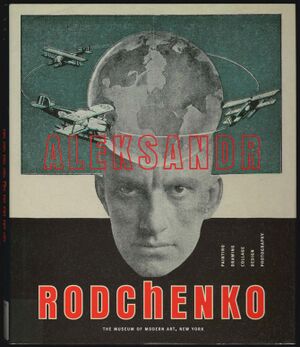
- Aleksandr Rodchenko, eds. Magdalena Dabrowski, Leah Dickerman and Peter Galassi, New York: Museum of Modern Art, and London: Thames & Hudson, 1998, 336 pp. Online companion. Review: Railing (Art Book 2000). (English)
- Rodchenko: Constructing the Future, Barcelona: Caixa Catalunya, 2008, 287 pp. On the occasion of an exhibition curated by Jean-Claude Marcadé and Evgeniya Petrova at La Pedrera, Barcelona, 13 Oct 2008-5 Jan 2009. Review: Railing (Art Book 2009). (English)
- Rodchenko and Popova: Defining Constructivism, ed. Margarita Tupitsyn, London: Tate, 2009, 190 pp. On the occasion of an exhibition at Tate Modern, 12 Feb-17 May 2009. Review: Railing (Art Book 2009). (English)
- Rodchenko and His Circle: Constructing the Future Through Photography, ed. John Milner, London: Art Sensus, 2011, 118 pp. On the occasion of an exhibition at Art Sensus, 20 Jan-19 Mar 2011. (English)
- Rabochiy klub [Рабочий клуб], Moscow: Tretyakov Gallery, 2011, [10] pp. (Russian)
- Alexander Rodchenko. Photography and Design, ed. Denise Rigaud, Vaduz: Kunstmuseum Liechtenstein, 2015, [17] pp, IA, ARG. Exh. booklet. (English)
Literature[edit]

- David Elliott (ed.), Alexander Rodchenko, Oxford: Museum of Modern Art, 1979, 136 pp. (English)
- Christina Lodder, "Aleksandr Rodchenko", in Lodder, Russian Constructivism, Yale University Press, 1983, pp 22-29. (English)
- Hubertus Gaßner, Alexander Rodschenko. Konstruktion 1920 oder die Kunst, das Leben zu organisieren, Frankfurt am Main: Fischer, 1984. (German)
- Selim O. Khan-Magomedov, Le opere di Aleksandr Rodčenko, 1891-1956, ed. Vieri Quilici, trans. Silvana de Vidovich, Milan: Idea Books, 1986, 303 pp. (Italian)
- Rodchenko: The Complete Work, intro. & ed. Vieri Quilici, MIT Press, 1986, 303 pp. Reviews: Margolin (Slavic East Eur J), Lodder (Oxford Art J), Elliott (Russian Rev), Bowlt (Leonardo). (English)
- Christina Kiaer, "Rodchenko in Paris", October 75 (Winter 1996), pp 3-35. (English)
- Christina Lodder, "Promoting Constructivism: Kino-fot and Rodchenko's Move Into Photography", History of Photography 24:4 (2000), pp 292-299. (English)
- Brandon Taylor, "Aleksandr Rodchenko’s Lines of Force", Tate Papers, 2009. (English)
- Renée-Claude Landry, Revolution by Design: Photography & Graphic Applications Mobilized by Constructivist Aleksandr Rodchenko in the 1920's Soviet Journal "Novy Lef", Montréal: Université du Québec, 2013. Dissertation. (English)
See also[edit]
- Varvara Stepanova
- Russia#Avant-garde
- Central and Eastern Europe#Constructivists, Futurists
- Central and Eastern Europe#Photography
Links[edit]
- Aleksandr Rodchenko at MoMA.org
- http://konstruktivizm.com/category/alexander-rodchenko
- Rodchenko & Popova exhibition in Tate London, 2009
- http://artblart.wordpress.com/2011/08/09/exhibition-alexander-rodchenko-revolution-in-photography-at-fotomuseum-winterthur-zurich/
- http://masters-of-photography.com/R/rodchenko/rodchenko.html
- http://calitreview.com/2842
- http://www.e-flux.com/journal/view/132
- http://www.chtodelat.org/index.php?option=com_content&view=article&id=558%3Aproductionism-art-of-the-revolution-or-design-for-the-proletariat&catid=204%3A01-25-what-is-the-use-of-art&Itemid=455&lang=en
- http://leb.nlr.ru/search/?scope=docs&query=Родченко
- Rodchenko's photographs
- http://www.togdazine.ru/tag/rodchenko
- Rodchenko on Wikipedia
